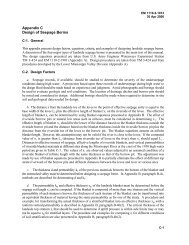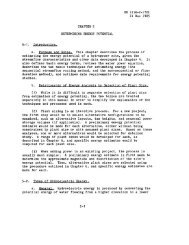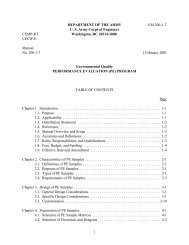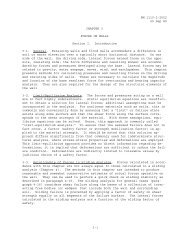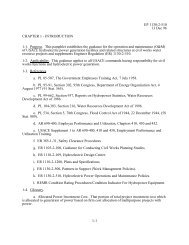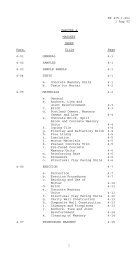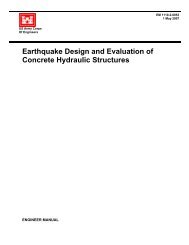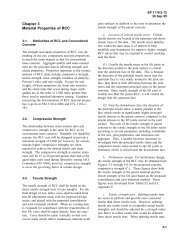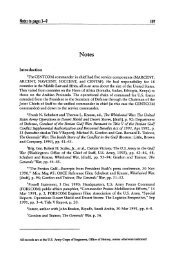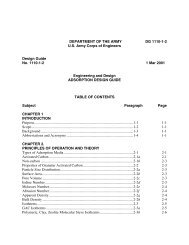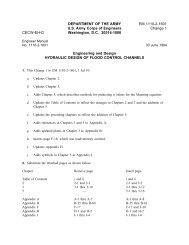em2901.chp:Corel VENTURA - Publications, US Army Corps of ...
em2901.chp:Corel VENTURA - Publications, US Army Corps of ...
em2901.chp:Corel VENTURA - Publications, US Army Corps of ...
You also want an ePaper? Increase the reach of your titles
YUMPU automatically turns print PDFs into web optimized ePapers that Google loves.
EM 1110-2-2702<br />
1 Jan 00<br />
(1) Skin plate design considerations. The skin plate design stress should be based on the negative<br />
moment at the supports for equally spaced interior ribs (fixed-end moment). The spacing between the<br />
exterior ribs at the ends <strong>of</strong> the gate should be adjusted such that the moment does not exceed the fixed-end<br />
moment <strong>of</strong> the interior spans. For gates with a wire rope hoist, thicker plate and/or closer rib spacing is<br />
normally required under the wire rope due to the rope pressure exerted on the plate. Because <strong>of</strong> the<br />
varying loading on the skin plate, it may be economical to vary the thickness <strong>of</strong> the plate over the height <strong>of</strong><br />
the gate. For gates less than approximately 3m (10 ft) high, it is generally economical for the entire skin<br />
plate to be <strong>of</strong> one thickness. It is recommended to maintain a minimum thickness <strong>of</strong> 10 mm (3/8 in.),<br />
while a thickness greater than 20 mm (3/4 in.) will rarely be required for any gate.<br />
(2) Rib design considerations. Although wide-flange or built-up sections are acceptable, structural tee<br />
sections with the web welded to the skin plate are recommended for ribs. In determining member<br />
geometric properties, an effective width <strong>of</strong> skin plate is assumed to act as the upstream flange <strong>of</strong> the<br />
vertical rib. The effective width be <strong>of</strong> skin plate shall be based on width-to-thickness ratios for compact or<br />
noncompact limits that are consistent with rib design assumptions. For rib sections that are considered as<br />
compact,<br />
3-32<br />
b<br />
e<br />
187t<br />
F<br />
y<br />
and for sections that are considered as noncompact,<br />
b<br />
e<br />
255t<br />
F<br />
y<br />
(3-13)<br />
(3-14)<br />
where t is the skin plate thickness. Economical design for the ribs will be achieved by locating the<br />
horizontal girders (rib support locations) to minimize the bending moments, Mu with positive and negative<br />
moments approximately equal.<br />
(3) Fabrication and maintenance considerations. General considerations are discussed in Appendix B.<br />
(a) Skin plate. All skin plate splices shall be full penetration welds and smooth transitions shall be<br />
provided at splices between plates <strong>of</strong> different thickness. Corrosion is controlled by protective coating<br />
systems and maintenance, and increasing skin plate thickness to allow for corrosion is not recommended.<br />
(Chapter 8.) However, due to inevitable wear and deterioration, it is appropriate to increase the skin plate<br />
thickness along the bottom <strong>of</strong> the gate or under wire ropes for gates with wire rope hoists.<br />
(b) Ribs. Ribs should be spaced and proportioned to provide adequate clearances required for<br />
welding and maintenance painting, even with a slight increase in steel quantity. The depth <strong>of</strong> the ribs<br />
must be sufficient to provide access for welding or bolting the rib flanges to the supporting girders. For<br />
welded construction, 200 mm (8 in.) has been considered a minimum rib depth in the past.<br />
c. Horizontal girder. Girders provide support for the skin plate assembly and transfer all loads from<br />
the skin plate assembly to the end frames. The girders act as rib supports and are generally located to<br />
achieve an economical design for the ribs. However, the location <strong>of</strong> girders also affects the load on each<br />
girder since the rib reactions are the girder loads. The overall economy considering the effect on girder<br />
design should be considered. The end frame (strut) design affects girder forces since the struts are the<br />
girder supports.




